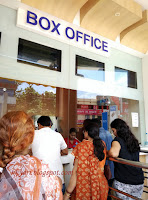Continued from the last blog - Sai Baba and 64-Yogini temple at Bhubaneswar, Orrisa !

Sri Ram-Mandir, Bhubaneswar

We returned from the 64 - Yogini Temple after "darshan" and it was well past 12 noon. Due to the temple visit we had not taken our breakfast. Today's temple visit was complete and we felt hungry. The driver stopped the vehicle near the "Sai Baba Temple" on the Cuttack - Puri bypass road. There were some roadside "Dhabas". We ate some "Pakodas", local biscuits and took tea. After taking refreshments we came back to hotel and took some rest. We decided to visit "Ram-Mandir" next day. So took our lunch and went to nearby 'City Market'. After a few hours we returned to our room. In the evening we all wanted to have some tea but the hotel tea was not to our like. Earlier we had tasted the tea of roadside stall near the 'Janpath'. My wife is a tea lover and said that the stall tea gives refreshment. She was not ready to have hotel tea. So we all went to the stall and ordered good strong tea made afresh. The old man said to wait for ten minutes started his work. We waited, chatted and saw the evening market and people. But within five minutes the sky was full of clouds and it started raining. There was hardly any shelter available there to keep us dry. The small two ft 'chhajja' projection of the shop was whatever available. First we tried to save our cloths but soon we realized that it was better to keep our head dry than cloths. It was my wife's persistence to come here so I was not happy but she and my daughter was enjoying this rain and said that such things remain in the memory lane for ever. They were true.
In the rainy season plenty of mushrooms are available in Bhubaneswar. At many places black colored mushrooms can be seen being sold at Rs 100 to 120 a kg. These look local products while in our city nowhere one can get less than Rs 200 a kg whatever be the type of mushroom. Even the mushroom dish in the hotels are available at half the price from our city. So whenever we come here mushroom dishes are on our top of the list for food. Between our hotel and railway station was a restaurant named "Ankit Hotel". It is a good place for food which is always full of visitors. We took our dinner there and came to room for a night's rest.
 |
| An idol with snake's head at the entrance of Ram Mandir, Bhubaneswar |
Next morning we got ready by 9:00 AM and called an auto for "Ram-Mandir". This temple is hardly 2-3 km from the hotel we stayed. It is a neat and clean temple with marble floors and outer walls having red in color. The front gate have many idols on its walls. Some of the idols attract attention because their heads are that of a snake. The main temple is a big hall at six ft above the ground level where devotees reach by ascending wide marble steps in the front. At the far end of the hall are three temples. Just in the front is idols of "Ram-darbar" while on the right is Hanuman temple. On the left hand is temple of Radha-Krishna. Each temple has its own "Pundit ji". We prayed in all these temples and got "Prasad". Then sat in the hall facing gods for some time.
Near the gate on both sides there are more temples in which Ganesh, Shiva, Durga and Rani Sati are main temples. In the Shiva temple the Pundit-Ji sits on its entrance and devotees are not allowed to enter the inside. But they have made an arrangement for the devotees to offer "Jal" (water) to "Shivalinga" from a small side window. An iron channel is fixed from the window to "Shivalinga" that helps water to fall on it. We bought some flowers and "Prasad" from shops just near the Shiva-temple. The flowers included "Lotus" too. Shiva likes "Lotus".
After the Shiva-Puja we said our "Pranam" in other temples. There is sufficient arrangement for water and "Drinking-water" to the left of the entrance.
 |
| The shop near the entrance of Ram Mandir,Bhubaneswar A good place for having "Nashta" |
Completing our Puja we took our slippers from the shoe-stand outside where we had deposited them. The person here is paid Rs 1.00 for each pair of shoes. Now we felt hungry and went to the shop just at the side of the "Ram-Mandir". This shop is simple in looking but its breakfast items (Nashta) are tasty and satisfying. There are many items and all fresh. That is why whenever we visit Bhubaneswar and come "Ram-Mandir" for puja, we take our breakfast here.

Box Office at INOX,
Bhubaneswar

Bhubaneswar



























